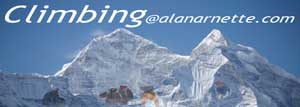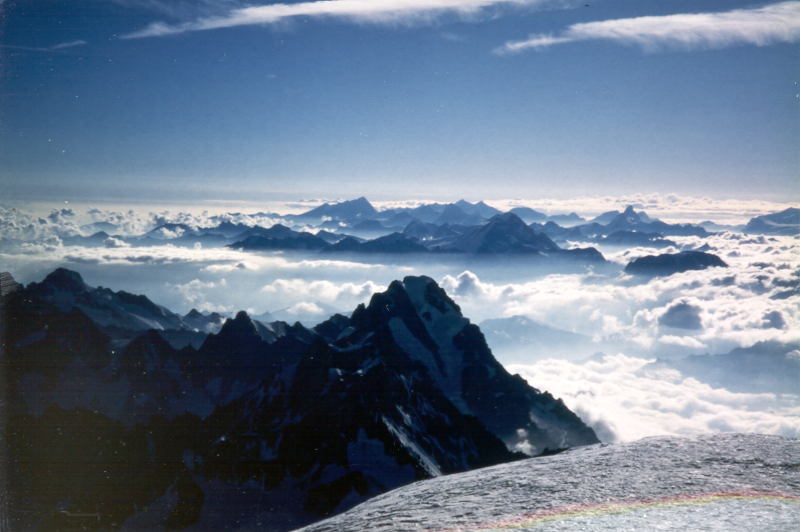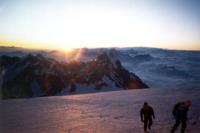
France/Italy
15,771 feet - 4807 meters
|
 |
Mont
Blanc FAQ France/Italy 15,771 feet - 4807 meters |
|||||||
|
||||||||
Mont Blanc arguably
has some the best alpine climbing in Europe. I am focusing on the
Three Mont-Blanc-route from the French side since it is very popular and
the one I climbed several times in 1998.
I am asked many questions about climbing especially since I am not a professional climber.
So here are the most popular questions with my answers. As always, this
information is based on my experience and are my opinions so always consult
with a professional before making any serious climbing decisions.
About Mont Blanc : Q: Where is it
Q: Where is it A: It is located in the French Alps on the boarder between Italy and France. It is actually "owned" by both countries under a bilateral agreement and is called Monte Bianco in Italy. Mont Blanc is a huge massif and is the tallest peak on the massif. The nearest airport is Geneva, Switzerland. It is about an hour drive or by train to Chamonix, France. Q: When is it usually climbed? A: As with most Northern Hemisphere peaks, Summer is best since every day it gets warmer with less threat of snow. I climbed it in July and August. Q: How hard is it? A: There are many routes which can vary from extremely difficult and technical to semi-technical. This means ropes, crampons and ice axe. Due to the crevasse danger, you usually rope up in teams. The ice climbing can be WF4 for short sections. My personal experience was mixed. The first time, I found it very challenging due to an extremely long day - 13 hours. The other times, it became easier with my improved conditioning and experience. I used a Guide from Chamonix on the first climb and soloed the other two. Q: How does Mont Blanc compare with Denali or Mt. Rainier? A: It is a serious climb where climbers experience long snow slopes and some steep sections. On most routes you use one of the huts to overnight and start early unlike winter camping conditions on Denali plus pulling a sled for weeks. So while it is similar in conditions to Denali it is not as significant in time or effort. In most respects it is more like Rainier with the multiple routes and the fact that most climbers do a summit climb in two days. Q: Is an Mont Blanc climb dangerous? A: Absolutely. In 2012, 9 climbers were killed in an avlanche of Mount Maudit on the popular Tres Mouts Traverse route. There is avalanche, crevasse and serac danger. You should only attempt Mont Blanc if you have the proper experience and logistics for emergency situations. It seems like each year a rouge storm hits the mountain in the summer creating dangerous icy conditions and multiple deaths occur. Over 100 climbers died just in the summer of 2008. The French and Italians have an amazing rescue service that now handles 800 calls a day! Q: How many people have summited and how many people had died trying? A: Between 20,000 and 30,000 people attempt Mont Blanc each year and an estimated 200-300 people a day summit in the summer season making it very crowded. Estimates doe deths vary widely from tens of thousands to hundreds, but we know some eyars see close to 100 deaths across all the Mont Blac peaks. Training, Gear & Communication:Q: How
did you train for this climb? The lower oxygen stimulates chemoreceptors that initiate an increase in breathing, resulting in a lowering of the partial pressure of CO2 and hence more alkaline blood pH. The kidneys begin to unload bicarbonate to compensate. Though this adaptation can take many days, up to 80% occurs just in the first 48 to 72 hours. There are many other physiologic changes going on, among them the stimulus of low oxygen to release the hormone, erythropoietin to stimulate more red blood cell production, a physiological and still acceptable form of blood doping that enhances endurance performance at low altitudes. Adaptive changes are not always good for one’s health. Some South American high altitude residents can have what’s called chronic mountain sickness, resulting from too many red blood cells; their blood can be up to 84-85% red blood cells. The increased blood viscosity and sometimes associated pulmonary hypertension can result in right heart failure. You cannot do much to acclimatize while at a low altitude but there are companies that claim to help the acclimatization process through specially designed tents that simulate the reduced oxygen levels at higher elevations. I have no personal experience with these systems but you can find more details at the Hypoxico website. They cost about $7,000 or can be rented for about $170 a week. Outside Magazine posted an article in 2013 questioning their effectiveness. Q: What kind of equipment did you use? Climbing Mont BlancQ: Which route is most popular? My ExperienceQ: Did you summit? A: Three
times: once in 1995 and twice in 1998. I used Mont Banc as a training
climb for my 8000m expeditions. A: Three
times: once in 1995 and twice in 1998. I used Mont Banc as a training
climb for my 8000m expeditions. Q: Did you use a guide ? A: Yes on my first time but went alone on the other climbs. Q: Who was the guide and how did you arrange it? A: It was French guide I found through the guide service in Chamonix France. He was quite good. There was a Frenchman with us and no one spoke English very well so it was quiet throughout the climb. The guide was quite safe and very competent. Q: Which route did you take? A: The Three Mont Blanc route which traverses over Mont Blanc du Tacul, Mont Maudit and up to Mont Blanc itself. It starts with a gondola ride to the Aiguille du Midi observation station in our full climbing gear and packs and then a fantastic short climb over a very steep and narrow snow ridge to the Cosmiques Hut. The actual climb took 13 hours the first time and under 10 the other two. The climbing is over long snow slopes with one section that is fixed and requires moderate climbing. I rappelled down this section on the return. Q: What kind of weather conditions did you experience? A: Hot and sunny, cold and windy - normal mountain weather. We were fortunate that the overall weather was good and we did not experience and sudden rain or snow squalls. Q: Would you climb Mont Blanc again? A: Probably not. While it was fun the first time, it has become very crowded these days and the weather so variable that it has become a dangerous climb. Bottom LineMont Blanc is a beautiful mountain in an awesome valley. The entire environment is amazing and makes you feel special. The French and Italian influence makes is unique for Americans. The climb itself is not technically difficult but does test your endurance. But the views from the summit are well worth it. |
|